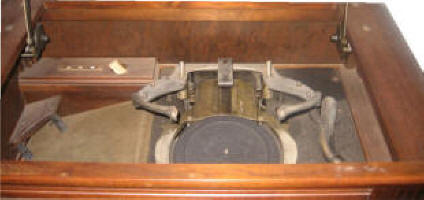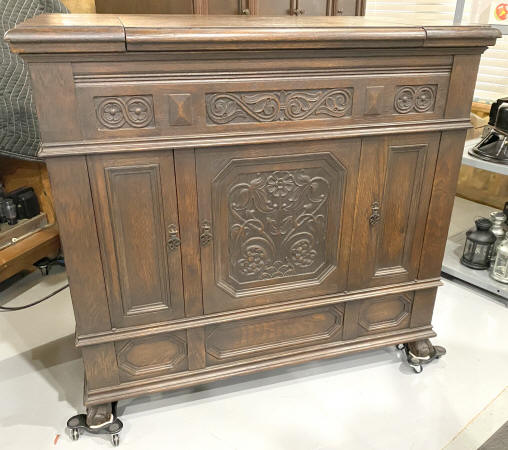
The Victor-Victrola Page
 VE 10-69
E
VE 10-69
E
RARITY: ¤¤¤¤ VALUE: ¤¤¤


 The
VE 10-69 was an automatic record-changer console with fully electronic
amplification, installed in an elegant Early English cabinet, in the buyer's choice of light or dark stained oak.
It was a phonograph-only model, without radio. Introduced in the fall of 1928,
the 10-69 offered Victor's 'Second Generation' automatic record changer
(right) in combination with a tube amplifier and paper-cone speaker. The concept of a
fully-automatic record changer was still relatively new in 1928; Victor had introduced
their first-generation design with the VE 10-50 a year earlier, but
this pioneering changer system was too costly to produce and took-up a great
deal of space, requiring a very large cabinet. The new (second-generation)
changer was a lower-cost and more compact system, but did not meet with much
success. The new design was prone to
mechanical problems and was arguably much harder on records than the earlier
version; completed discs were literally
"flung" off the turntable and into a storage area when each side was
completed. This same second-generation record changer was also used on the
VE 10-35 and 9-56 models as well
as a few others, but after experiencing slowing sales and ongoing reliability
complaints, the new design was quietly discontinued from production by January
1929.
The
VE 10-69 was an automatic record-changer console with fully electronic
amplification, installed in an elegant Early English cabinet, in the buyer's choice of light or dark stained oak.
It was a phonograph-only model, without radio. Introduced in the fall of 1928,
the 10-69 offered Victor's 'Second Generation' automatic record changer
(right) in combination with a tube amplifier and paper-cone speaker. The concept of a
fully-automatic record changer was still relatively new in 1928; Victor had introduced
their first-generation design with the VE 10-50 a year earlier, but
this pioneering changer system was too costly to produce and took-up a great
deal of space, requiring a very large cabinet. The new (second-generation)
changer was a lower-cost and more compact system, but did not meet with much
success. The new design was prone to
mechanical problems and was arguably much harder on records than the earlier
version; completed discs were literally
"flung" off the turntable and into a storage area when each side was
completed. This same second-generation record changer was also used on the
VE 10-35 and 9-56 models as well
as a few others, but after experiencing slowing sales and ongoing reliability
complaints, the new design was quietly discontinued from production by January
1929.
The 10-69 models were manufactured only during the final few months of 1928, but
this product remained in the Victor catalog through 1929. Sales of this model
(still in dealer stock) remained very sluggish, and by the following year, the
10-69 was being sold at a significant discount from list price. When The
Depression hit in October of 1929, sales of expensive machines ground to a halt.
By that time, RCA had purchased Victor and was evaluating what to do with the
vast amount of unsold inventory sitting in the factory. Per factory data, Victor made
around 1,800 10-69's expecting the same type of success they had experienced with the
VE 10-50 and other automatic-changing models; however these optimistic sales
figures were never realized, in part due to the unpopularity of
Victor's Second Generation changer system. A company-wide recall of the unreliable changer
mechanisms was undertaken shortly after the product was introduced. When the
changers were upgraded and returned to the owner or dealer, new data plates were
issued for the machines, and serial numbers were re-started at s/n 6330. So if
your machine has a serial number above 6330, it has the updated changer. If it
is prior to 6330, your machine was never sent back to the plant for the
necessary recall work. However, many serial numbers were skipped prior to 6330,
so it is nearly impossible to confirm the total factory output of this model.
In 1930, RCA promptly designed a less-complicated 'Third Generation' changer,
and paired it with the latest RCA radio, and put this new package into the
unsold 10-69 cabinets; it was then sold as the RCA "RAE-68" at a significantly
lower price. It is also possible that dealers and distributors returned
thousands of unsold 10-69 models to the factory, where they were gutted and
updated with the new RCA radio/phonograph system. Based on the serial numbers of
surviving examples, it appears that a very limited number of 10-69's were
actually sold over the course of a few years, while the predominant remainder
were converted into RAE-68 models. Consequently, making sense of surviving
serial numbers is nearly impossible.
The original 1928 selling price of the VE 10-70 was $850.00, which equates to
almost $13,000.00 in today's money. However, it is unlikely that very many
buyers actually paid this much for this model, since it was being discounted
shortly after introduction.
While collectors today prize these early automatic changer models, the
complexity of repair and required maintenance of these machines limits
the current market valuation.
The current survival database shows the earliest existent 10-69 to be S/N 562 and the latest to be S/N 9945.
Do you own a Victrola 10-69? Please take a moment and enter some basic information about your machine into the collector's database by clicking here. No personal information is required.